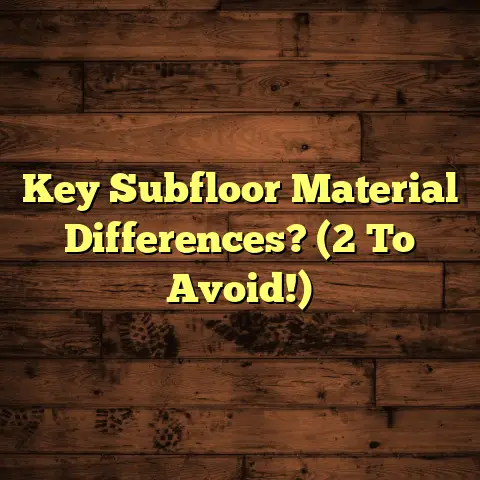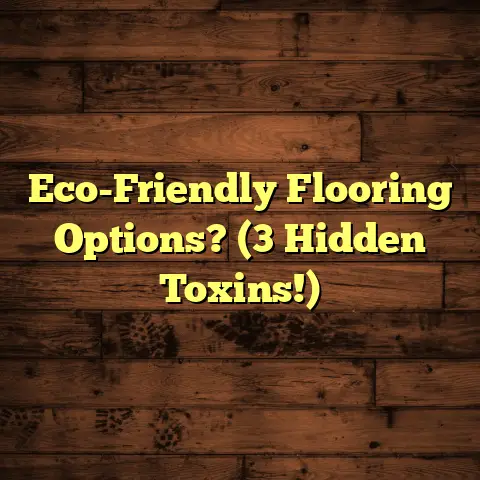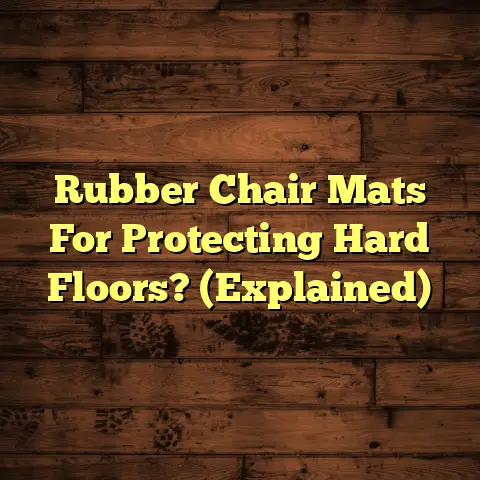Linoleum vs. Vinyl: Are They the Same? (9 Key Facts!)
Flooring has come a long way, hasn’t it? From simple dirt floors to the amazing array of materials we have today.
Two names that often pop up when folks are looking for something durable and easy to care for are linoleum and vinyl. They’re both resilient flooring options, meaning they have some “give” underfoot.
But are they the same thing? That’s what we’re going to dive into today.
Linoleum has a cool history. It dates back to the 19th century! Imagine that!
It was the original resilient flooring, and it became popular because it was made from natural stuff. Think linseed oil (from flax seeds), cork dust, wood flour, and rosin. Pretty eco-friendly, right?
Vinyl, on the other hand, is a more modern invention. It really took off in the mid-20th century. It’s a synthetic material, a product of our ever-advancing technology.
Both have been used in homes, schools, and commercial spaces for decades. But their stories, their makeup, and their impact are actually quite different.
Let’s get to the bottom of this linoleum vs. vinyl debate!
Section 1: Material Composition
Okay, let’s get down to the nitty-gritty – what are these floors actually made of?
Linoleum is the OG eco-friendly flooring. It’s made from primarily renewable resources.
Linseed oil is the star of the show. It’s extracted from flax seeds. Mix that with cork dust (leftover from making wine stoppers!), wood flour, rosin (a resin from pine trees), mineral fillers, and pigments, and you’ve got the basic recipe.
These ingredients are mixed together, then pressed onto a jute backing. Jute is a natural fiber, kind of like burlap.
Because it’s made from these natural goodies, linoleum is biodegradable. That means it can break down naturally over time.
Vinyl, on the other hand, is a synthetic material. The key ingredient here is polyvinyl chloride, or PVC. PVC is a type of plastic.
Vinyl flooring also contains plasticizers to make it flexible, stabilizers to prevent degradation, and pigments for color.
The big difference here is that vinyl is not biodegradable. It’s made from petroleum-based products, which raises some environmental concerns.
The durability of vinyl is undeniable, but the environmental impact is something to consider.
Section 2: Manufacturing Processes
So, how do they actually make these things?
Linoleum production is a fascinating process. First, the linseed oil is oxidized.
This thickens it into a kind of rubbery material. Then, the other ingredients – cork dust, wood flour, rosin, and pigments – are mixed in.
This mixture is then heated and pressed onto that jute backing I mentioned earlier. The whole thing is then cured, kind of like baking a giant cookie.
This curing process can take several weeks, and it’s what gives linoleum its unique characteristics.
Vinyl flooring production is a bit more high-tech. PVC resin is mixed with plasticizers, stabilizers, and pigments.
This mixture is then either calendared (rolled out into sheets) or coated onto a backing material. The backing can be felt, fiberglass, or another layer of vinyl.
Then, the design layer is printed on. This is where the magic happens – the layer that makes vinyl look like wood, stone, or any other pattern you can imagine.
Finally, a wear layer is applied on top to protect the design. This wear layer is usually made of clear vinyl or urethane.
Section 3: Design and Aesthetic Options
Alright, let’s talk about looks! How do these floors stack up when it comes to design?
Linoleum has a cool, classic look. The colors tend to be more muted and natural-looking, reflecting its natural composition.
It can be printed with intricate designs, and the color goes all the way through the material. That means if you scratch it, the color is still there underneath.
You can find linoleum in solid colors, marbled patterns, and even geometric designs.
Vinyl flooring is where you can really go wild with design. Because it’s printed, you can create almost any look imaginable.
Want the look of hardwood without the cost and maintenance? Vinyl can do that.
How about the look of stone or tile? No problem. Vinyl can even mimic the texture of these materials.
You can find vinyl in a huge range of colors, patterns, and styles. It’s a really versatile option for any décor.
Section 4: Durability and Longevity
How long will these floors last? That’s a big question, right?
Linoleum is known for its durability. It’s a tough, resilient material that can stand up to a lot of wear and tear.
Because the color goes all the way through, it doesn’t show scratches and dents as easily as some other flooring types.
With proper care, a linoleum floor can last for decades. I’ve seen properly maintained linoleum floors in older homes that are still going strong after 50+ years.
Vinyl flooring’s durability depends a lot on the quality of the wear layer. The thicker the wear layer, the more resistant it is to scratches, dents, and stains.
A good-quality vinyl floor can last for 10-20 years, or even longer, with proper care.
One of the biggest differences I’ve seen is how they age. Linoleum tends to develop a patina over time, a sort of aged beauty. Vinyl, on the other hand, can fade or yellow with age.
Section 5: Installation Process
Let’s talk about getting these floors installed. Is it a DIY job, or should you call in the pros?
Linoleum installation can be a bit tricky. It’s usually best left to the professionals.
It requires careful cutting and fitting, and the seams need to be properly sealed to prevent water damage.
Also, linoleum needs to be installed on a very smooth, level subfloor. Any imperfections in the subfloor will show through.
Vinyl flooring is generally easier to install than linoleum. Some types of vinyl flooring, like vinyl plank and click-lock vinyl, are designed for DIY installation.
However, even with vinyl, it’s important to prepare the subfloor properly. It needs to be clean, dry, and level.
For both linoleum and vinyl, you need to make sure you’re using the right adhesive. The manufacturer’s instructions will tell you which type to use.
Section 6: Maintenance and Care
Alright, let’s talk about keeping these floors looking their best.
Linoleum is relatively easy to care for. Regular sweeping or vacuuming is a must to remove dirt and debris.
For cleaning, use a mild detergent and a damp mop. Avoid harsh chemicals or abrasive cleaners, as they can damage the surface.
One thing to keep in mind with linoleum is that it needs to be sealed periodically. This helps to protect the surface and prevent staining.
Vinyl flooring is even easier to care for than linoleum. It’s naturally stain-resistant and waterproof.
Just like with linoleum, regular sweeping or vacuuming is important. For cleaning, you can use a damp mop and a mild detergent.
Avoid using abrasive cleaners or scouring pads, as they can scratch the surface.
One thing I’ve noticed is that vinyl can be prone to fading in direct sunlight. So, if you have a lot of windows, you might want to consider using curtains or blinds.
Section 7: Environmental Impact
Let’s talk about the green factor. How do these floors impact the environment?
Linoleum is the clear winner here. It’s made from primarily renewable resources, and it’s biodegradable.
The linseed oil, cork dust, wood flour, and rosin are all natural materials that can be replenished.
Also, linoleum production doesn’t generate a lot of harmful emissions.
Vinyl, on the other hand, has a bigger environmental footprint. It’s made from PVC, which is a petroleum-based plastic.
The production of PVC can release harmful chemicals into the environment. Also, vinyl is not biodegradable, so it can end up in landfills for a very long time.
However, there are some efforts to recycle vinyl flooring. Some manufacturers are now offering take-back programs, where they’ll recycle old vinyl floors into new products.
Section 8: Cost Comparison
Let’s talk about the bottom line: how much do these floors cost?
Linoleum generally costs more than vinyl. The material itself is more expensive, and the installation costs are usually higher as well.
You can expect to pay anywhere from $5 to $15 per square foot for linoleum, installed.
Vinyl flooring is generally more affordable. You can find vinyl flooring for as little as $2 per square foot, and even high-end vinyl flooring rarely exceeds $10 per square foot, installed.
Here’s a quick cost comparison table:
| Flooring Type | Material Cost (per sq ft) |
|---|---|
| Linoleum | $3 – $8 |
| Vinyl | $1 – $5 |
| Flooring Type | Installation Cost (per sq ft) |
|---|---|
| Linoleum | $2 – $7 |
| Vinyl | $1 – $5 |
Keep in mind that these are just averages. The actual cost will depend on the quality of the material, the complexity of the design, and the labor rates in your area.
Section 9: Conclusion: Are They the Same?
So, are linoleum and vinyl the same? The answer is a resounding NO!
They’re both resilient flooring options, but that’s about where the similarities end.
Linoleum is a natural, eco-friendly material that’s known for its durability and classic look. It’s a great choice for people who are looking for a sustainable flooring option.
Vinyl is a synthetic material that’s known for its versatility and affordability. It’s a great choice for people who want a wide range of design options and a budget-friendly price.
Which one is right for you? That depends on your specific needs, preferences, and values.
If you’re looking for an eco-friendly, durable flooring option and you’re willing to pay a little more, linoleum is a great choice.
If you’re looking for an affordable, versatile flooring option and you don’t mind a synthetic material, vinyl is a great choice.
Call to Action:
So, what do you think? Are you leaning towards linoleum or vinyl? Maybe you’re still not sure.
That’s okay! The important thing is to do your research and choose the flooring that’s right for you.
Think about your lifestyle, your budget, and your environmental values. Then, go out there and find the perfect flooring to complete your dream home!




